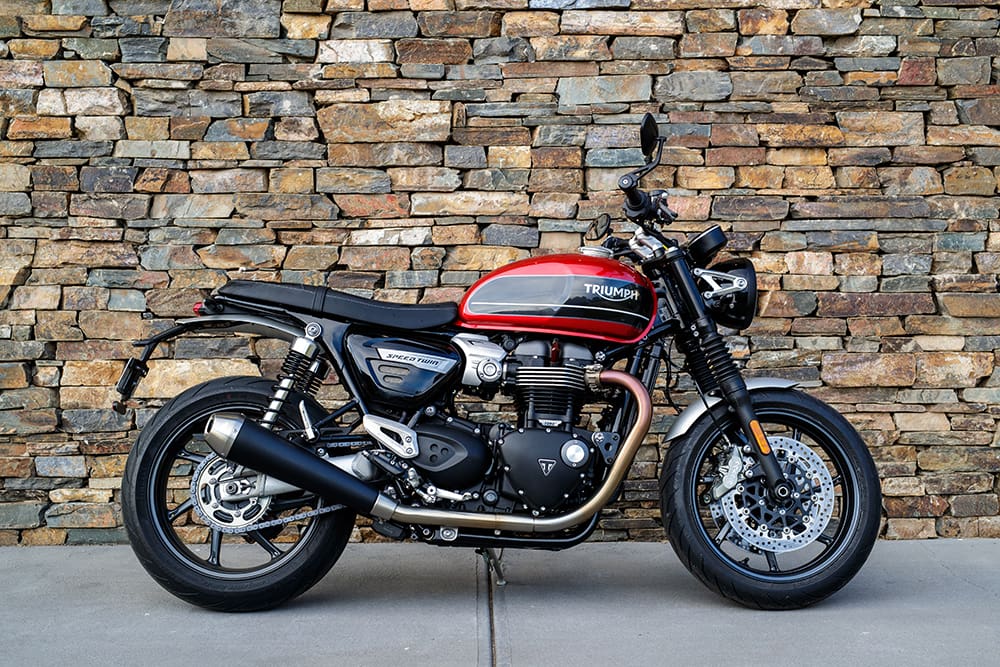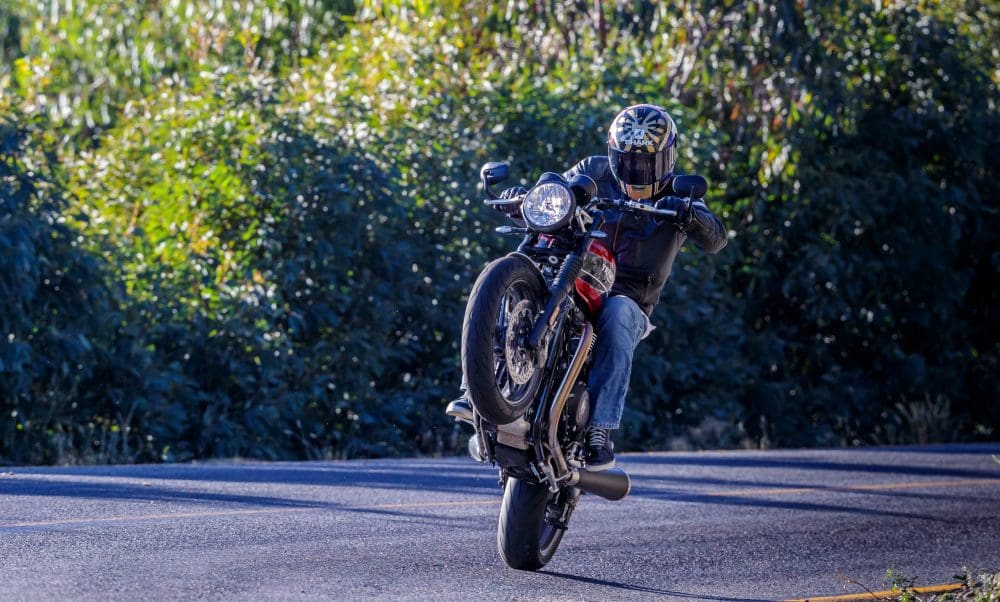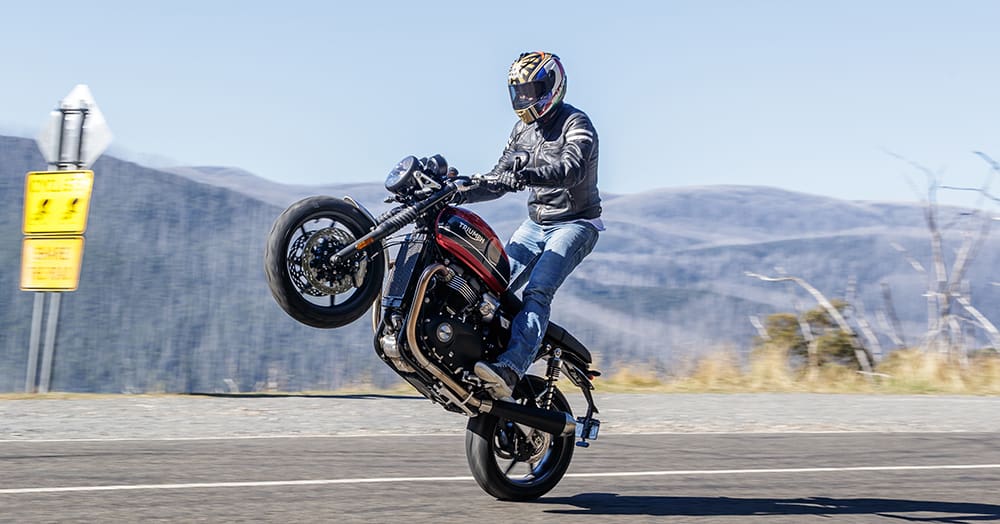Can Triumph’s Speed Twin earn its place on Aussie soil?
Placing a new motorcycle between your bargain modern classic Street Twin and the incredibly fun and highly accomplished Thruxton 1200R is a brave move for Triumph. Not so brave, however, when you spot the monster engine output upgrade over the lesser model and realise it’s housed in a chassis only marginally less accomplished than the high-spec model. Instead it’s all of a sudden an inspired decision. Triumph’s new Speed Twin is more, for less.
According to Triumph, the $13,700 (plus on-road costs) 2019 Street Twin 900 is 49 percent in arrears to the $18,000 (plus on-road costs) Speed Twin when it comes to peak horsepower. That kind of grunt upgrade is a wallet opener, particularly when its peak numbers go close to matching the most expensive bike in the Classic range, the $21,100 (plus on-road costs) Thruxton R.
What this power also does to what looks like a conservative retro bike, is give it life! Lots of sparkly, wheel-lofting life. Think of it as a retro big-bore naked rather than a doughy old man’s bike. It can be that – and there’s nothing wrong with that – but a stroke of the clutch lever lifts its skirts easier than I dreamed. This bike is a lively ride if you want it to be.
I – somehow – had missed riding a Triumph retro Classic up until this point. So looking at them lined up in a Melbourne street ahead of our two-day Aussie launch ride (we ran the world launch report in Vol 68 No 17), I guess I can be forgiven for assuming she would be a pretty mild old ride.
Wrong. Utterly wrong, I was.

I do love the looks, as conservative as I find them. There is no doubting the build quality, something I have come to expect from Triumph, and the Korosi Red option is my pick – so that’s what I hung my helmet on at the
start of the ride.
Triumph has done a great job of integrating some useable tech for the new Speed Twin, too, including the neat instrument package and a USB output for charging devices that was so well hidden, I never found it until right at the end (I wasn’t looking for it, but it is discreet). There’s LED lighting, tyre-pressure sensor capability, rider modes, ride-by-wire throttle and even traction control, but experience has told me all those bolt-ons mean nothing, if the engine and chassis don’t get on well together. As I punched the amiable Speed Twin onto its back wheel out of a second-gear corner, I knew that ratio was spot-on.
Speaking of ratios, the bottom five gears are short-ish, helpful with the acceleration and wheelie endeavours, while an overdrive sixth lets the cruise stay within reasonable revs. If I was riding this bike far, often, I’d want some more legs in the lower gears. As it stands, it’s great for all manners of riding. It shifts beautifully, too.
Deep in a conga line of riders, the Speed Twin was proving its myriad strengths; that punchy, yet under-stressed engine and liquid smooth power delivery; an ease of riding few other 1200s match; a solid, easy to understand chassis and an all round ‘together’ feel. As a package, it works great, like all the good bikes do. There was just one niggle.
The engine is excellent, the gearbox superb and the brakes are perfectly suited to the bike – close to flawless for the design brief. Which all ganged up on the fork, the one piece of equipment not quite up to the same level as the rest of the package.
It doesn’t do anything wrong, it just lacks feel and suppleness. This is highlighted by a very capable chassis and engine package, and with the Thruxton R’s superior front end (albeit with a price tag to match) as an example of what this bike could be, the 41mm KYB fork is a standout.

It doesn’t ruin anything, it just means if you’re looking for something to upgrade, you’d start there. That, and the Vance & Hines brushed alloy silencers…
Better yet, how about an R version of this bike? A Speed Twin R with Thruxton R boingers and an even sharper tune from the engine is a tantalising prospect. That said, sifting through the 80-plus options for that something extra from the accessories catalogue isn’t hard.
Then there’s the brakes. The twin front Brembo four-piston hardware will howl the front Pirelli Rosso Corsa 3 rubber time and again with precision, feel and sheer stopping power, along with the most delicious lever feel I’ve felt in a while. I never thought I’d be writing that about a retro classic, but they simply fit this bike to perfection. I’d prefer I had the option to remove ABS when needed, but otherwise, they are close to being flawless stoppers.
In the Speed Twin, Triumph has produced a bike that is easy to ride and something I would be happy recommending to someone not long off their P plates. But hidden by the lush paint, retro stylings and mellow face, there’s a side to it that, once let off the leash, scratches the itch for whom a ride is adrenalin-spec, rather than coffee and cruise-focussed.
There’s firm competition in this sector, though Triumph’s mention of the Kawasaki Z900RS is a little off target, I reckon – both bikes go about their business very differently, despite similar-era styling and pricing. The BMW R Nine T Pure ($20,290) and Ducati Scrambler 1100, however, are very much in its line of fire.
If a retro classic excites you with its looks, but you need something with bark and spark to match the thrills, then the Speed Twin is worth a test ride. Riders with more budget will likely pick the Thruxton R all day long, but the Speed Twin is enough of a step above the Street Twin to have riders working a second job to get on that instead.

Test SAM MACLACHLAN Photography MARK DADSWELL
See Vol 68 No 21 for the full report